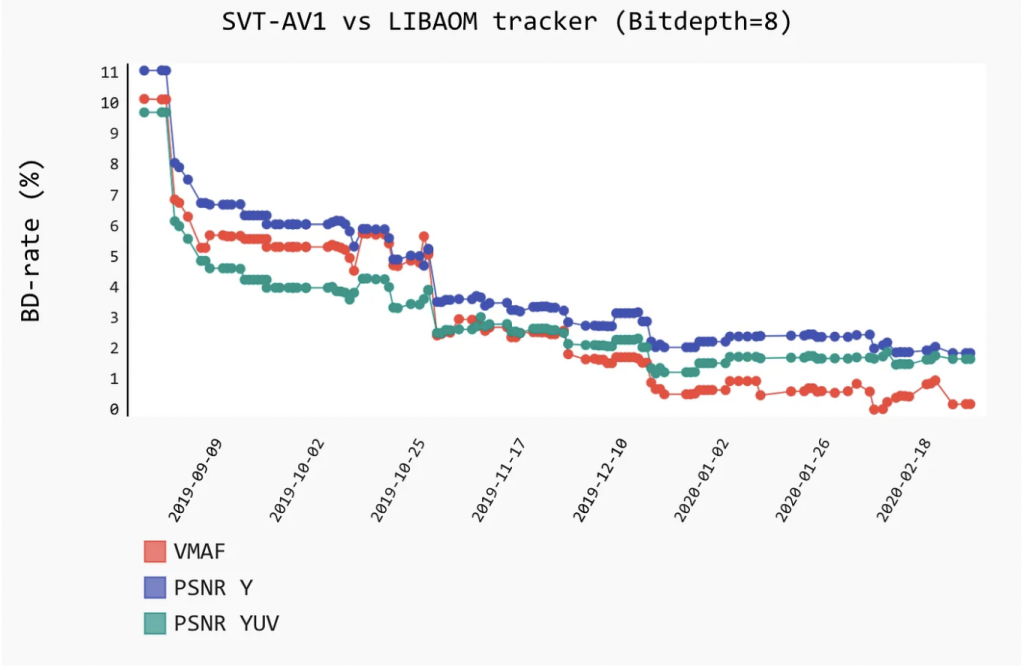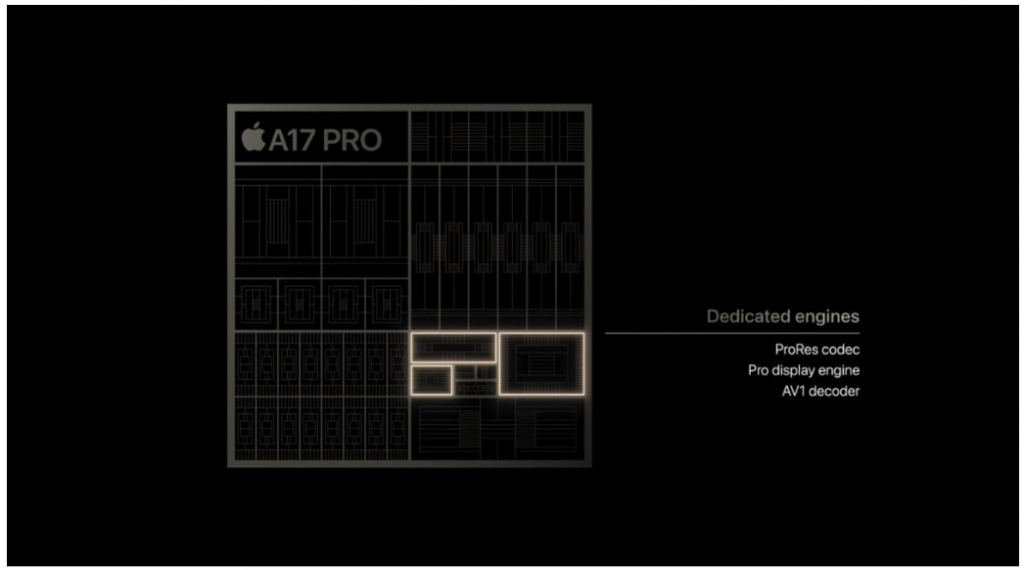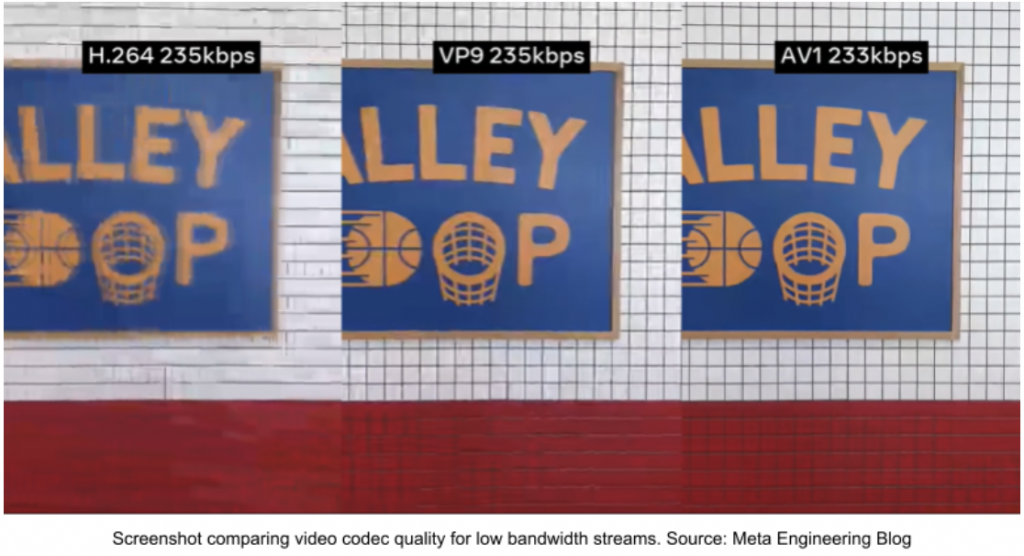Our project is going smoothly. Right now, we’re checking out SVT-AV1, which is how Netflix uses AV1 with the help of Intel. We’re digging into how efficient it is. Plus, we’ve begun putting together our final report, and next up, we’ll start working on our demo presentation. Things are shaping up nicely!
Progress List
Finalize project idea and proposal.Get the website and URL setupProject summaryBackground of AV1 encoding in video streamingTechnical understanding of AV1Update websiteNetflix implementationEfficiency analysis & User experienceUpdate website with new contents- Presentation/Demo
- Submit the final report
AV1 at Netflix
Netflix consistently advances video compression and analysis due to the high frequency of their content playback—every saved bit translates to real cost savings. An exemplary illustration of this commitment is Netflix’s development of the Video Multimethod Assessment Fusion (VMAF) metric. Created in collaboration with two universities, VMAF serves as a key tool for evaluating video quality through computer analysis and has remained integral to Netflix’s work.
VMAF is utilized to validate results from Netflix’s Per-Shot Encoding, a technique adjusting encoding parameters for each shot in a film, deviating from fixed parameters for the entire film. This innovative approach has been discussed in previous talks, including insights into Netflix’s per-title encoding.

Figure 1: Netflix AV1
Netflix’s significant contribution to the video codec landscape is AV1. As a founding member of the Alliance for Open Media (AoM), Netflix recognized the need for a better codec. By contributing to an open standard, Netflix not only addressed its own requirements but also fostered a collaborative community, attracting contributions to both the codec’s development and widespread adoption.
Recent developments include streaming AV1 to Android clients, taking advantage of AV1’s native support for 10-bit video—a distinguishing feature from other codecs like AVC and HEVC. There are visual enhancements in scenes such as skies and water achieved through the use of 10-bit.

Figure 2: VMAF (quality metric) vs Bitrate
Another standout feature of AV1 is Film Grain synthesis, designed to enhance encoding efficiency by removing random film grain during encoding and reapplying similar noise to maintain the original aesthetic. This technique can result in up to a 30% reduction in bitrate. Netflix has collaborated with Intel on the SVT-AV1 software video encoder. Leveraging Intel’s SVT technology optimized for Xeon chips, SVT-AV1 aims to increase adoption by delivering a data center-ready, optimized encoder.
SVT-AV1: open-source AV1 encoder and decoder
The Scalable Video Technology for AV1 (SVT-AV1) is an open-source AV1 codec implementation developed collaboratively by Intel and Netflix. SVT-AV1 aims to provide high performance and scalability in AV1 video encoding. A collaboration between Intel and Netflix since August 2018, this project has seen active contributions from other partner companies and the open-source community since its open-sourcing. It is available on GitHub under a BSD + patent license.
Architectural Features
Intel aimed to create a high-performance and scalable AV1 encoder with SVT-AV1. The encoder employs parallelization at various stages of the encoding process, adapting to the number of available cores, thus reducing encoding time while maintaining compression efficiency. Key architectural features include multi dimensional parallelism, multi-stage partitioning decisions, block-based mode decisions, RD-optimized classification, and open-loop hierarchical motion estimation.
One of the key architectural features of SVT-AV1 is its multi-stage partitioning decision mechanism. This feature is crucial in the encoding process as it determines how to divide the video frames into smaller partitions for more efficient compression. SVT-AV1 utilizes multi- dimensional parallelism in this partitioning decision, optimizing the use of available computing resources, especially multiple CPU cores. This allows SVT-AV1 to adapt to the number of available cores, including newer servers with a significant core count.

Figure 3: Multi-stage multi-class mode decision
Additionally, SVT-AV1 employs a multi-stage class mode decision approach. Mode decision is a fundamental aspect of video encoding where the encoder determines the best coding mode (such as inter or intra prediction) for each block in a frame. The multi-stage class mode decision in SVT-AV1 involves a classification process that helps the codec make informed decisions about the coding mode for different blocks. This can significantly impact compression efficiency and overall video quality.
These multi-stage decisions in SVT-AV1 contribute to achieving a balance between compression efficiency and performance. By optimizing the partitioning and mode decision processes through multiple stages, SVT-AV1 can efficiently utilize computing resources, resulting in competitive compression efficiency and reduced encoding time.
Compression Efficiency and Performance
In terms of compression efficiency, SVT-AV1 rivals libaom at slow speed settings. The encoder’s performance improvements over time can be observed on the Video Codec Tracker website. SVT-AV1’s 2-pass encoding mode, utilizing 4-thread mode, competes well with libaom. The encoder shows a 16.5% decrease in encoding time compared to libaom, while maintaining slightly superior compression efficiency, as indicated by various quality metrics like PSNR, VMAF, and MS-SSIM.

Figure 4: SVT-AV1 vs LIBOM
Current Development
Current state of AV1 playback support (2023), covering which browsers, mobile devices, smart TVs, consoles and streaming sticks are compatible with AV1 codec so far. On Sep 12, 2023, Apple announced the A17 Pro chip in their new iPhone 15 Pro would include a dedicated AV1 decoder. This is a big line in the sand for Apple and for the wider industry and will hopefully prove to be the day that revitalized interest and momentum for AV1 adoption across the industry.

Figure 5: Apple A17 Pro Chip
In the beginning of 2023, as anticipation grew for Apple’s official endorsement of AV1, Meta took proactive steps by independently incorporating AV1 support for their Reels videos on Facebook and Instagram, extending to iOS devices. Meta expressed confidence in AV1 as the most promising codec for their video products in the foreseeable future. The accompanying image illustrates the substantial enhancement in visual quality achieved with AV1 in comparison to VP9 and H.264, all while maintaining a consistent bitrate.

Figure 6: H.264 vs VP9 vs AV1
Generally speaking, the Chrome browser and Android ecosystem handle AV1 well across phones, tablets, smart TVs and set-top boxes/streaming sticks. Unfortunately, the same cannot be said for Safari and iOS where support had been lacking until the iPhone 15 Pro announcement.

Figure 7: AV1 Software Support